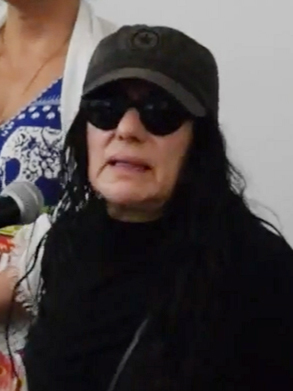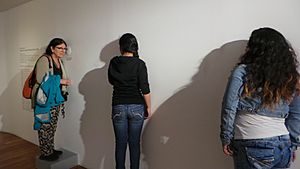Teresa Margolles facts for kids
Quick facts for kids
Teresa Margolles
|
|
|---|---|
 |
|
| Born |
Teresa Margolles
1963 (age 62–63) |
| Alma mater | National Autonomous University of Mexico |
| Known for | Photography Videography Performance art Conceptual art |
| Awards | Prince Claus Award (2012) Artes Mundi (2012) |
Teresa Margolles (born 1963) is a Mexican artist who uses photography, video, and installations to create her art. She is known for making conceptual art, which focuses on the ideas behind the artwork. Her work explores the difficult topic of death and how it affects society.
Margolles often gets her ideas from visiting morgues, which are places where deceased people are taken to find out how they died. She uses her art to show the sadness and social problems that can result from a person's death. Her work is not just about the person who died, but also about the family and friends left behind.
The materials she uses in her art often come from the morgues themselves. She turns these materials into experiences for the audience that make them think and feel. Margolles believes that what happens inside a morgue shows the truth about what is happening in the world outside. For example, she noticed that in Mexico City, many of the people who died from violence came from poorer communities. She once said, "Looking at the dead you see society."
Contents
Life and Art Career
Teresa Margolles grew up in Culiacán, a city in the state of Sinaloa, Mexico. From a young age, she saw the effects of violence in her community. She later moved to Mexico City for her education. At first, she was interested in photography and studied political science. She became fascinated with forensic science after spending time with medical students who were training nearby.
From Science to Art
Margolles trained to be a forensic pathologist, a type of doctor who studies the causes of death. She earned degrees in science and forensic medicine from the National Autonomous University of Mexico. She also studied art. This unique mix of science and art became the foundation of her work.
For Margolles, the morgue is a place that reflects what is happening in society. In Mexico, social problems and crime have led to a lot of violence. Her art asks people to think about these issues.
In 1990, Margolles and other artists started a group called SEMEFO. The name was based on the title of the official coroner's office in Mexico. The group used materials from death investigations to create art that commented on the violence in their country. Margolles left the group in the late 1990s to work on her own.
Creating Art from Life's End
As a solo artist, Margolles continued to explore themes of death and social problems. She often uses materials from the morgue where she worked. For example, she has used the water from the morgue to create her art. She explained, "The water comes from Mexico City’s morgue. It’s water used to wash the bodies of people who died from violence."
One of her famous exhibitions was Muerte Sin Fin (Death Without End) in 2004. In one part of the exhibit, a machine filled a room with soap bubbles. The bubbles were made from the special water from the morgue. This was meant to remind people how fragile life is.
Another piece in the same exhibit, called Papeles, featured sheets of paper stained with water from the morgue. These papers served as portraits to remember the people whose lives were lost.
Major Artworks and Exhibitions
Margolles has shown her art all over the world, bringing attention to important social issues.
Venice Biennale
In 2009, Margolles represented Mexico at the Venice Biennale, a famous international art exhibition. Her show was called "What Else Could We Speak About?". It explored the impact of violence in Mexico. One piece was a flag that had been colored with materials from places where violent events had occurred. Another piece featured jewelry made from glass taken from broken windows at these sites.
Trafalgar Square Installation
In 2024, Margolles created a sculpture for the Fourth plinth in London's Trafalgar Square. The work, called “A Thousand Times in an Instant,” is a large cube covered with 726 plaster masks. These masks were molded from the faces of transgender and non-binary people from Brazil and the United Kingdom.
The sculpture is a type of memorial. It was inspired by ancient skull racks from Mexico called tzompantli. The artwork is dedicated to her friend, a transgender woman who was a victim of violence in 2015. Art critics praised the piece as a powerful and dignified memorial.
Awards and Recognition
- In 2012, she received the Prince Claus Award from the Netherlands.
- In 2012, she also won the Artes Mundi prize, an international award for contemporary art.
Her work is part of major museum collections, including the Tate in London. The Tate owns two of her pieces, including Flag I, which is similar to the one shown at the Venice Biennale.
Selected Exhibitions
Margolles has had solo shows and participated in group exhibitions at many famous museums and galleries.
- 2004: Museum für Moderne Kunst, Frankfurt am Main, Germany
- 2005: Guggenheim Museum, New York, U.S.
- 2009: Venice Biennale (Mexican pavilion), Italy
- 2010: Los Angeles County Museum of Art (LACMA), Los Angeles, U.S.
- 2014: Centro de Arte Dos de Mayo, Madrid, Spain
- 2018: Padiglione D'Arte Contemporanea (PAC), Milan, Italy
- 2019: Venice Biennale
- 2024: Fourth plinth in Trafalgar Square, London.
Public Collections
Her art can be found in the permanent collections of museums around the world, including:
- Pérez Art Museum Miami, Florida
- Museum of Modern Art, New York
- Centre Pompidou, Paris
- Museum für Moderne Kunst, Frankfurt, Germany
- Tate Modern, London, United Kingdom
Further Reading
- Kittelmann, Udo & Klaus Görner (2004) Teresa Margolles. Muerte sin fin, Ostfildern-Ruit, ISBN: 978-3-7757-1473-0
- Margolles, Teresa (2011) Margolles, Teresa. Frontera, Walther König, Cologne, ISBN: 978-3-86560-976-2
- Downey, Anthony (2009) "127 Cuerpos: Teresa Margolles and the Aesthetics of Commemoration", Lund Humphries, London, ISBN: 978-1-84822-016-4
- Heartney, Eleanor; Posner; Princenthal; Scott (2013) The Reckoning: Women Artists of the New Millennium, published by Prestel Verlag, pp. 206 – 213, [[ISBN|ISBN: 978-3-7913-4759-2]]
- Sileo, Diego. (2019) Teresa Margolles: Ya Basta ..., Silvana Editorale, ISBN: 978-8836639168


